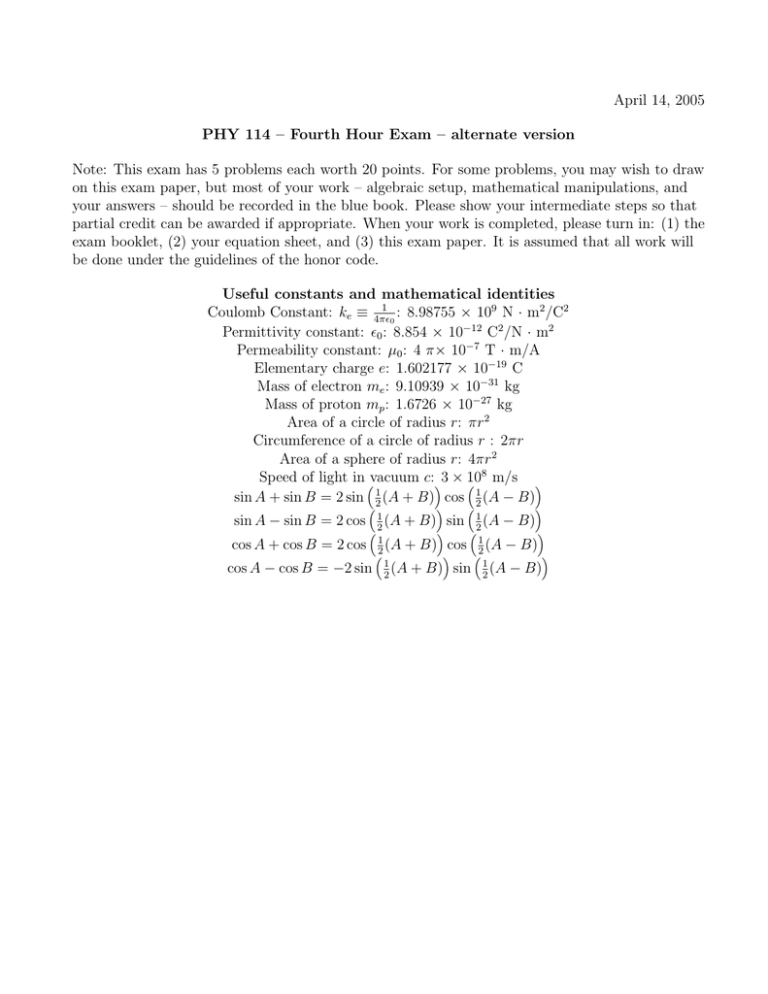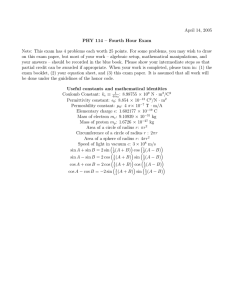April 14, 2005
advertisement

April 14, 2005
PHY 114 – Fourth Hour Exam – alternate version
Note: This exam has 5 problems each worth 20 points. For some problems, you may wish to draw
on this exam paper, but most of your work – algebraic setup, mathematical manipulations, and
your answers – should be recorded in the blue book. Please show your intermediate steps so that
partial credit can be awarded if appropriate. When your work is completed, please turn in: (1) the
exam booklet, (2) your equation sheet, and (3) this exam paper. It is assumed that all work will
be done under the guidelines of the honor code.
Useful constants and mathematical identities
1
Coulomb Constant: ke ≡ 4π
: 8.98755 × 109 N · m2 /C2
0
Permittivity constant: 0 : 8.854 × 10−12 C2 /N · m2
Permeability constant: µ0 : 4 π× 10−7 T · m/A
Elementary charge e: 1.602177 × 10−19 C
Mass of electron me : 9.10939 × 10−31 kg
Mass of proton mp : 1.6726 × 10−27 kg
Area of a circle of radius r: πr2
Circumference of a circle of radius r : 2πr
Area of a sphere of radius r: 4πr2
8
Speed of light in vacuum c:3 × 10
m/s sin A + sin B = 2 sin 12 (A + B) cos 12 (A − B)
1
(A + B) sin 12 (A − B)
2
cos A + cos B = 2 cos 12 (A + B) cos 12 (A − B)
cos A − cos B = −2 sin 12 (A + B) sin 12 (A − B)
sin A − sin B = 2 cos
1.
The figure above shows an idealized diagram of a human eye with a variable focus lens
located 2.5 cm in front of the retina. The following questions concern the relationships
between the object distance p, the focal length of the lens f , and the image distance i,
assumed to be on the retina. To receive full credit for this problem, draw at least one
appropriate ray diagram and answer questions (a), (b), and either (c) or (d).
(a) What is the effective focal length of the eye lens for seeing an object 80 cm in front of
the eye?
(b) What is the effective focal length of the eye lens for seeing an object 8 cm in front of
the eye?
(c) Suppose that the maximum focal length of your eye is 2.3 cm. Using as much
quantitative detail as you can, explain how an eyeglass lens placed 1 cm from the eye
lens can bring the object at a distance of 80 cm into focus on your retina.
(d) Suppose that the minimum focal length of your eye is 2.0 cm. Using as much
quantitative detail as you can, explain how an eyeglass lens placed 1 cm from the eye
lens can bring the object at a distance of 8 cm into focus on your retina.
2. An electromagetic wave is propagating along the x−axis and its electric field can be
described as the sum of two contributions:
E(x, t) = {5 cos(0.0003x − 90000t) + 5 cos(0.0003x − 90000t + 1.2)} ŷ.
(1)
In this expression, the electric field is expressed in units of N/C, the phase is expressed in
radians, x is in meters, and t is in seconds.
(a) What is the maximum amplitude of the composite electric field?
(b) What is the maximum amplitude of the composite magnetic field?
(c) What is the maximum intensity of the the electromagnetic wave?
3.
The figure above shows a plot of the intensity pattern produced on a screen at the front of
the lecture hall when a source at the back of the hall passes through a diffracting device.
The distance from device at the back of the lecture hall to the screen at the front (to the
point marked 0 in the plot) is 15 m. The horizonal axis of the plot represents the the
horizontal diffraction pattern where the distance y is measured in meters. The plot shows
the diffraction pattern of two colors of light with peak intensity positions in units of meters.
The distance between slits in the diffracting device is 6 ×10−6 m.
(a) From the form of the intensity pattern, what can you say about the diffracting device?
(b) From the data in the plot, estimate the wavelengths of the light in the source.
4. An astronomer on Earth observes a spectral signal from a distant star. The signal is found
to have a wavelength of λobs = 450nm, however, this particular spectral feature would have a
wavelength of λrest = 600nm if the source were at rest.
(a) Is the star moving toward or away from the Earth?
(b) What is the velocity of the star relative to the Earth?
5.
Suppose you have discovered a new unstable particle “A”. If you capture N0 “A” particles in
a container (assuming their velocities are essentially zero), the fractional number of
undecayed particles present in your container is represented in the plot above, as a function
of time ( in µs).
(a) How long does it take for
1
2
of the “A” particles to decay in your container?
(b) Now suppose that these same kind of “A” particles are also found in cosmic rays. To
measure them, you set up detectors at the top and bottom of a mountain of height
h = 4000 m.
i. Suppose that you find that the average time interval that an “A” particle takes to
travel from the top of the mountain to the bottom is ∆tEarth frame = 16.6666 µs.
What is the average velocity of these cosmic “A” particles?
ii. Using the graph and ignoring the theory of relativity, what fraction of the cosmic
“A” particles would you expect to survive the trip from the top of the mountain to
the bottom?
iii. Your experiment finds that 12 particles survive the trip. Using the theory of special
relativity in as much quantitative detail that you can, explain the experimental
result. (For this purpose you can assume that cosmic particle are moving at
essentially constant velocity.)
*******************End of Exam*********************






